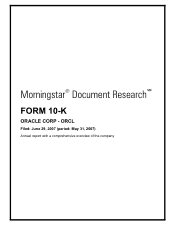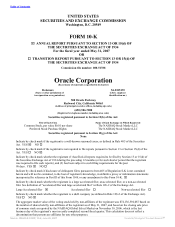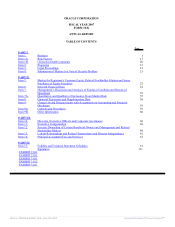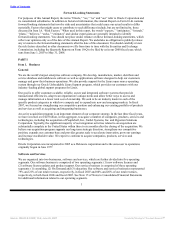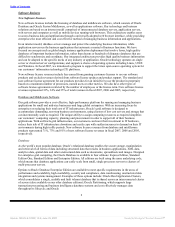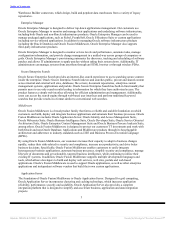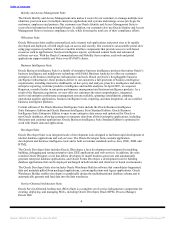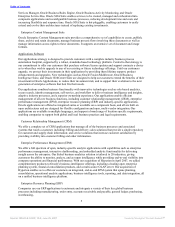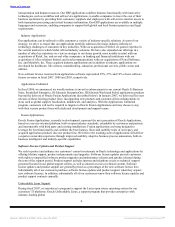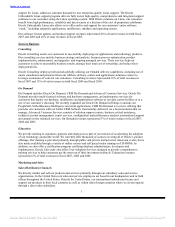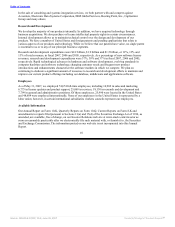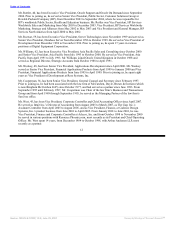Oracle 2006 Annual Report Download - page 7
Download and view the complete annual report
Please find page 7 of the 2006 Oracle annual report below. You can navigate through the pages in the report by either clicking on the pages listed below, or by using the keyword search tool below to find specific information within the annual report.
Table of Contents
Warehouse Builder connectors, which design, build and populate data warehouses from a variety of legacy
repositories.
Enterprise Manager
Oracle Enterprise Manager is designed to deliver top-down applications management. Our customers use
Oracle Enterprise Manager to monitor and manage their applications and underlying software infrastructure,
including both Oracle and non-Oracle infrastructure products. Oracle Enterprise Manager can be used to
manage packaged applications, such as Siebel, PeopleSoft, Oracle E-Business Suite or custom applications
including service-oriented applications. In addition to managing Oracle software infrastructure products
including the Oracle Database and Oracle Fusion Middleware, Oracle Enterprise Manager also supports
third-party infrastructure products.
Oracle Enterprise Manager is designed to monitor service levels and performance, automate tasks, manage
configuration information, and provide change management in a unified way across groups of computers or
grids. Oracle Enterprise Manager’s provisioning automates the discovery, tracking and scheduling of software
patches and allows IT administrators to apply patches without taking their system down. Additionally, IT
administrators can manage systems from anywhere through an HTML browser or through wireless PDAs.
Secure Enterprise Search
Oracle Secure Enterprise Search provides an internet-like search experience to users searching secure content
inside the enterprise. Oracle Secure Enterprise Search indexes and searches public, private and shared content
across internal and external web sites, databases, file servers, document repositories, enterprise content
management systems, applications and portals. Oracle Secure Enterprise Search has built-in functionality that
permits users to see only search results leading to information for which they have authorized access. The
product features a simple web interface allowing for efficient administration and management. Additionally,
users can access the search engine through web-based user interfaces and perform traditional keyword
searches that provide results in a format similar to conventional web searches.
Middleware
Oracle Fusion Middleware is a broad product family that forms a reliable and scalable foundation on which
customers can build, deploy and integrate business applications and automate their business processes. Oracle
Fusion Middleware includes Oracle Application Server, Oracle Identity and Access Management Suite,
Oracle Webcenter Suite, Oracle Business Intelligence Suite, Oracle Developer Suite, Oracle Service Oriented
Architecture Suite, Oracle Enterprise Content Management Suite and Oracle Business Process Analysis Suite,
among others. Oracle Fusion Middleware is designed to protect our customers’ IT investments and work with
both Oracle and non-Oracle Database, Applications and Middleware products through its hot-pluggable
architecture and adherence to industry standards such as J2EE and Business Process Execution Language
(BPEL).
By using Oracle Fusion Middleware, our customers increase their capacity to adapt to business changes
rapidly, reduce their risks related to security and compliance, increase user productivity, and drive better
business decisions. Specifically, Oracle Fusion Middleware enables customers to easily integrate
heterogeneous business applications, automate business processes, simplify security and compliance, manage
lifecycle of documents and get actionable, targeted business intelligence, while continuing to utilize their
existing IT systems. In addition, Oracle Fusion Middleware supports multiple development languages and
tools, which allows developers to build and deploy web services, web sites, portals and web-based
applications. Oracle’s Fusion Middleware is used to support Oracle applications, as well as other enterprise
applications and independent software vendors that build their own custom applications.
Application Server
The foundation of Oracle Fusion Middleware is Oracle Application Server. Designed for grid computing,
Oracle Application Server incorporates clustering and caching technology, which increases application
reliability, performance, security and scalability. Oracle Application Server also provides a complete
integration platform that is designed to simplify and accelerate business, application and data integration
projects.
3
Source: ORACLE CORP, 10-K, June 29, 2007 Powered by Morningstar® Document Research℠

